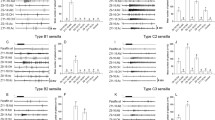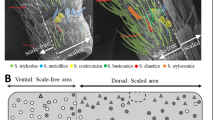Abstract
The stimulation effect of the two enantiomers of the male-produced aggregation pheromone, ipsdienol, was tested by electrophysiological recordings from single olfactory cells in females of two species,Ips pini andI. paraconfusus. The results demonstrated two types of receptor cells, each specialized to one of the optical configurations. This suggests that separate acceptors (membrane receptors) for (+)- and (−)-ipsdienol are produced by the beetles' receptor cells. The dose-response curves obtained for the 92% “pure” enantiomers and racemic mixtures indicated no synergistic or inhibitory interaction of the enantiomers on the receptor cells. The results could be explained by activation of one acceptor type in each cell group.
I. paraconfusus apparently had the majority of its ipsdienol cells keyed to the (+)-enantiomer. Conversely, the westernI.pini had more cells tuned to (−)- than to (+)-ipsdienol. This difference is consistent with behavioral responses where these species are sympatric in California. The (+)- and (−)-ipsdienol are aggregation pheromone components ofI. paraconfusus anaI. pint, respectively, and the opposite enantiomers act as aggregation inhibiting allomones. More (−)- than (+)-ipsdienol cells were also obtained in the easternI. pint, even though this population produces more (+)- than (−)-ipsdienol (63∶35) and requires both enantiomers for aggregation behavior. However, the difference in the numbers of (+)- and (−)-ipsdienol cells recorded from the eastern population was insufficient for an acceptable level of statistical confidence.
Similar content being viewed by others
References
Angst, M.E., andLanier, G.N. 1979. Electroantennogram responses of two populations ofIps pini (Coleoptera: Scolytidae) to insect-produced and host tree compounds.J. Chem. Ecol 5:129–138.
Birch, M.C., andLight, D.M. 1977. Inhibition of the attractant pheromone response inIps pini and I.paraconfusus (Coleoptera: Scolytidae): Field evaluation of ipsenol and linalool.J. Chem. Ecol. 3:257–267.
Birch, M.C., andWood, D.L. 1975. Mutual inhibition of the attractant pheromone response by two species ofIps. (Coleoptera: Scolytidae)J. Chem. Ecol. 1:101–113.
Birch, M.C., Light, D.M., andMori, K. 1977. Selective inhibition of response ofIps pini to its pheromone by the (S)-(−)-enantiomer of ipsenol.Nature 270:738–739.
Birch, M.C., Light, D.M., Wood, D.L., Browne, L.E., Silverstein, R.M., Bergot, B.J., Ohloff, G., West, J.R., andYoung, J.C. 1980. Pheromonal attraction and allomonal interruption ofIps pini in California by the two enantiomers of ipsdienol.J. Chem. Ecol. 6:703–717.
Boeckh, J., andBoeckh, V. 1979. Threshold and odour specificity of pheromone-sensitive neurons in the deutocerebrum ofAntheraea pernyi andA. polyphemus (Saturnidae).J. Comp. Physiol. 132:235–242.
Kafka, W.A. 1970. Molekulare Wechselwirkung bei der Erregung einzelner Riechzellen.Z. Vergl. Physiol. 70:105–143.
Kaissling, K.E. 1974. Sensory transduction in insect olfactory receptors, pp. 243–273,in L. Jaenicke (ed.). Biochemistry of Sensory Functions. 25th Mosbacher Colloquium. Springer Verlag, Heidelberg.
Lanier, G.N., Birch, M.C., Schmitz, R.F., andFurniss, M.M. 1972. Pheromones ofIps pini (Coleoptera: Scolytidae): Variation in response among three populations.Can. Entomol. 104:1917–1923.
Lanier, G.N., Claeson, A., Stewart, T., Piston, J.J., andSilverstein, R.M. 1980. The basis for interpopulational differences in pheromone biology.J. Chem. Ecol. 6:677–687.
Light, D.M., andBirch, M.C. 1979. Inhibition of the attractive pheromone Response inIps paraconfusus by R-(−)-ipsdienol.KOM Nawi 726:1–2.
Mustaparta, H., Angst, M.E., andLanier, G.N. 1978. Responses of single receptor cells in the pine engraver beetle,Ips pini (Say) (Coleoptera: Scolytidae) to its aggregation pheromone, ipsdienol and the aggregation inhibitor, ipsenol.J. Comp. Physiol. 121:343–347.
Mustaparta, H., Angst, M.E., andLanier, G.N. 1979. Specialization of olfactory cells to insect- and host produced volatiles in the bark beetle speciesIps pini(Say).J. Chem. Ecol. 5:109–123.
Ohloff, G., andGiersch, W. 1977. Access to optically active ipsdienol from verbenone.Helv. Chim. Acta 60:1496–1500.
Ritschel, W.A. 1973. Angewandte Biopharmazie. Wissenschaftliche Verlagsgesellschaft MBH, Stuttgart.
Silverstein, R.M. 1979. Enantiomeric composition and bioactivity of chiral semiochemicals in insects, pp. 133–146,in F.J. Ritter (ed.). Chemical Ecology: Odour Communication in Animals. Elsevier, North Holland.
Silverstein, R.M., Rodin, J.O., andWood, D.L. 1966. Sex attractants in frass produced by maleIps confusus in ponderosa pine.Science 154:509–510.
Author information
Authors and Affiliations
Rights and permissions
About this article
Cite this article
Mustaparta, H., Angst, M.E. & Lanier, G.N. Receptor discrimination of enantiomers of the aggregation pheromone ipsdienol, in two species ofIps . J Chem Ecol 6, 689–701 (1980). https://doi.org/10.1007/BF00987679
Received:
Revised:
Issue Date:
DOI: https://doi.org/10.1007/BF00987679




